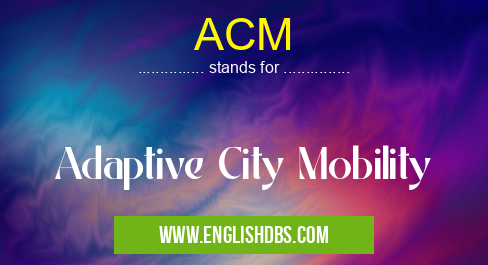What does ACM mean in UNCLASSIFIED
Adaptive City Mobility (ACM) is an innovative concept that aims to optimize urban mobility systems by leveraging advanced technologies and data-driven approaches. It encompasses a wide range of strategies and solutions to enhance the efficiency, accessibility, and sustainability of transportation within cities.

ACM meaning in Unclassified in Miscellaneous
ACM mostly used in an acronym Unclassified in Category Miscellaneous that means Adaptive City Mobility
Shorthand: ACM,
Full Form: Adaptive City Mobility
For more information of "Adaptive City Mobility", see the section below.
Key Elements of ACM
- Data Collection and Analysis: ACM relies on real-time data collection from various sources, such as sensors, cameras, and mobile devices, to gain insights into traffic patterns, parking availability, and transit usage.
- Intelligent Traffic Management: By analyzing traffic data, ACM systems can adjust traffic signals, optimize routing, and provide real-time information to drivers to improve traffic flow and reduce congestion.
- Smart Parking Solutions: ACM implements technologies to guide drivers to available parking spaces, reduce search times, and streamline payment processes.
- Enhanced Public Transit: ACM integrates public transit systems with other modes of transportation, providing seamless multimodal travel options and improving accessibility for all.
- Mobility-as-a-Service (MaaS): ACM promotes MaaS platforms that offer users integrated access to various transportation services, including public transit, ride-sharing, and bike-sharing, through a single interface.
Benefits of ACM
- Reduced Congestion and Emissions: Improved traffic management and smart parking solutions can alleviate traffic congestion, leading to reduced travel times, emissions, and air pollution.
- Enhanced Accessibility: By providing real-time information, optimizing public transit, and integrating different modes of transportation, ACM improves accessibility for all, including those with disabilities or limited mobility.
- Improved Economic Efficiency: Optimized traffic flow and reduced congestion can boost economic activity by reducing travel costs, improving productivity, and attracting businesses.
- Increased Safety: Intelligent traffic management systems can enhance safety by detecting hazardous situations, providing alerts, and improving infrastructure design.
Essential Questions and Answers on Adaptive City Mobility in "MISCELLANEOUS»UNFILED"
What is ACM (Adaptive City Mobility)?
ACM is a comprehensive urban mobility concept that aims to optimize transportation systems in cities by integrating various technologies, including sensors, data analytics, and intelligent infrastructure. It seeks to enhance traffic flow, reduce congestion, improve air quality, and promote sustainable transportation.
How does ACM work?
ACM leverages real-time data from sensors, cameras, and other devices to monitor traffic conditions and identify inefficiencies. This data is then analyzed to create dynamic traffic management plans that can adjust traffic signals, optimize public transportation schedules, and provide real-time information to drivers. By adapting to changing demand and conditions, ACM aims to improve overall traffic flow.
What are the benefits of ACM?
ACM offers numerous benefits, including:
- Reduced traffic congestion and improved travel times
- Enhanced air quality by reducing vehicle emissions
- Improved public transportation efficiency and accessibility
- Enhanced pedestrian and cyclist safety
- Data-driven decision-making for urban planning and policy
How is ACM implemented?
Implementing ACM typically involves a collaborative effort between city governments, transportation agencies, and technology providers. It requires the installation of sensors and intelligent infrastructure, integration with existing traffic management systems, and the development of data analytics platforms. Pilot programs and comprehensive planning are often involved in the implementation process.
What are some examples of ACM technologies?
ACM incorporates advanced technologies such as:
- Smart traffic signals that adjust timing based on real-time traffic data
- Intelligent intersections that prioritize vehicles and pedestrians for efficient flow
- Connected vehicles that communicate with infrastructure for enhanced safety and navigation
- Traffic data visualization and analytics platforms that provide insights for decision-making
Final Words: Adaptive City Mobility is a transformative concept that has the potential to revolutionize urban transportation systems. By leveraging technology and data, ACM aims to create more efficient, accessible, and sustainable cities, improving the quality of life for residents and visitors alike.
ACM also stands for: |
|
| All stands for ACM |
